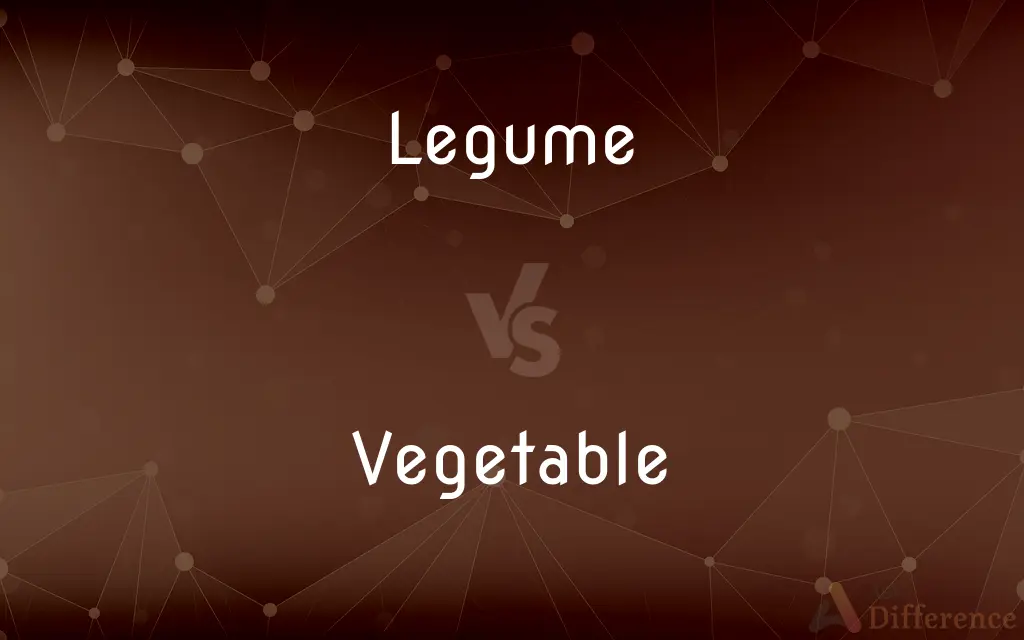Legume vs. Vegetable — What's the Difference?
By Tayyaba Rehman — Updated on October 29, 2023
Legumes are seeds from the pods of plants in the Fabaceae family; vegetables are edible parts of plants like roots, leaves, and stems.

Difference Between Legume and Vegetable
Table of Contents
ADVERTISEMENT
Key Differences
Legumes are a class of vegetables that specifically refer to the family Fabaceae, also known as the pea family. They include the seeds and sometimes the pods of these plants, which are distinguished by their high protein content. Examples of legumes include beans, lentils, peas, and peanuts. Legumes are often considered both a protein and a vegetable due to their nutrient profile.
Vegetables, on the other hand, encompass a broader category of edible plant parts. This can include leaves (lettuce), stems (celery), roots (carrots), flowers (broccoli), and bulbs (onion). Unlike legumes, vegetables generally offer a wider variety of vitamins and minerals and are usually lower in protein.
Legumes are unique among vegetables for their ability to fix nitrogen in the soil, a trait that stems from their symbiotic relationship with certain bacteria. This nitrogen-fixing ability makes them important in agriculture for soil health. Vegetables do not share this characteristic and are grown primarily for their nutritional value and flavor.
In culinary terms, legumes are often used as a meat substitute because of their high protein content. They can be the main feature of a dish, like in a bowl of chili or lentil soup. Vegetables, while they can also be the star of a dish, are more commonly used to add flavor, texture, or as a side dish.
The term "vegetable" is more of a culinary term, while "legume" has both a botanical and culinary use. In a botanical sense, legumes are defined by their specific plant family, while in the kitchen, they are identified by the part of the plant consumed that contains seeds within a pod.
ADVERTISEMENT
Comparison Chart
Botanical Family
Fabaceae family.
Various plant families.
Edible Parts
Seeds and sometimes pods.
Roots, leaves, stems, flowers, bulbs, etc.
Protein Content
High in protein.
Generally low in protein.
Culinary Use
Often a meat substitute, main dish.
Used for flavor, texture, side dish.
Agricultural Trait
Nitrogen-fixing plants.
No nitrogen fixation.
Compare with Definitions
Legume
Plant family Fabaceae.
Lentils are a nutritious legume.
Vegetable
Culinary versatility.
She roasted a medley of vegetables.
Legume
High-protein seeds.
Legumes are great for vegetarians.
Vegetable
Varied nutrition profiles.
Vegetables provide essential vitamins.
Legume
Dietary staple worldwide.
Chickpeas are a popular legume in many cuisines.
Vegetable
Can be leafy, root-based, etc.
Spinach is a leafy vegetable.
Legume
Seed-bearing pods.
She added legumes to her garden.
Vegetable
Integral to diets globally.
Vegetables are vital for health.
Legume
Nitrogen-fixing plants.
Legumes enrich the soil.
Vegetable
Vegetables are parts of plants that are consumed by humans or other animals as food. The original meaning is still commonly used and is applied to plants collectively to refer to all edible plant matter, including the flowers, fruits, stems, leaves, roots, and seeds.
Legume
A legume () is a plant in the family Fabaceae (or Leguminosae), or the fruit or seed of such a plant. When used as a dry grain, the seed is also called a pulse.
Vegetable
A plant cultivated for its edible parts, such as the roots of the beet, the leaves of spinach, the flower buds of broccoli, or the fruit or seeds of certain species, as beans, corn, and squash.
Legume
A plant of the pea family.
Vegetable
The edible part of such a plant.
Legume
A pod of such a plant, which splits into two valves with the seeds attached to one edge of the valves.
Vegetable
A member of the vegetable kingdom, especially a green plant.
Legume
Such a pod or seed used as food. Peas, beans, and lentils are legumes.
Vegetable
Offensive Slang One who is severely impaired mentally and physically, as by brain injury or disease.
Legume
(botany) The fruit or seed of leguminous plants (as peas or beans) used for food.
Vegetable
Of, relating to, or derived from plants or a plant
Vegetable dyes.
Legume
(botany) Any of a large family (Fabaceae, syn. Leguminosae) of dicotyledonous herbs, shrubs, and trees having fruits that are legumes or loments, bearing nodules on the roots that contain nitrogen-fixing bacteria, and including important food and forage plants (as peas, beans, or clovers).
Vegetable
Made from or with edible plants or plant parts
Vegetable lasagna.
Legume
(botany) A pod dehiscent into two pieces or valves, and having the seed attached at one suture, as that of the pea.
Vegetable
Growing or reproducing like a plant.
Legume
A pod dehiscent into two pieces or valves, and having the seed attached at one suture, as that of the pea.
Vegetable
Any plant.
Legume
The fruit of leguminous plants, as peas, beans, lupines; pulse.
Vegetable
A plant raised for some edible part of it, such as the leaves, roots, fruit or flowers, but excluding any plant considered to be a fruit, grain, herb, or spice in the culinary sense.
Legume
An erect or climbing bean or pea plant of the family Leguminosae
Vegetable
The edible part of such a plant.
Legume
The fruit or seed of any of various bean or pea plants consisting of a two-valved case that splits along both sides when ripe and having the seeds attached to one edge of the valves
Vegetable
A person whose brain (or, infrequently, body) has been damaged so that they cannot interact with the surrounding environment; a person in a persistent vegetative state.
Legume
The seedpod of a leguminous plant (such as peas or beans or lentils)
Vegetable
Of or relating to plants.
Vegetable
Of or relating to vegetables.
Vegetable
Of or pertaining to plants; having the nature of, or produced by, plants; as, a vegetable nature; vegetable growths, juices, etc.
Blooming ambrosial fruitOf vegetable gold.
Vegetable
Consisting of, or comprising, plants; as, the vegetable kingdom.
Vegetable
Plants having distinct flowers and true seeds.
Vegetable
A plant. See Plant.
Vegetable
A plant used or cultivated for food for man or domestic animals, as the cabbage, turnip, potato, bean, dandelion, etc.; also, the edible part of such a plant, as prepared for market or the table.
Vegetable
A person who has permanently lost consciousness, due to damage to the brain, but remains alive; sometimes continued life requires support by machinery such as breathing tubes. Such a person is said to be in a vegetative state.
Vegetable
Edible seeds or roots or stems or leaves or bulbs or tubers or nonsweet fruits of any of numerous herbaceous plant
Vegetable
Any of various herbaceous plants cultivated for an edible part such as the fruit or the root of the beet or the leaf of spinach or the seeds of bean plants or the flower buds of broccoli or cauliflower
Vegetable
Of the nature of or characteristic of or derived from plants;
Decaying vegetable matter
A mineral deposit
Mineral water
Vegetable
Edible plant or plant part.
Carrots are his favorite vegetable.
Common Curiosities
Is a carrot a legume?
No, a carrot is a root vegetable, not a legume.
Are all vegetables legumes?
No, legumes are a specific type of vegetable from the Fabaceae family.
What exactly is a legume?
A legume is a seed or pod from the family Fabaceae, high in protein.
Are peas and beans both legumes?
Yes, both peas and beans are considered legumes.
Can legumes be eaten raw?
Some legumes can be toxic if eaten raw and usually require cooking.
Do all legumes need to be shelled?
Many legumes like peas and peanuts are shelled, but some can be eaten whole.
Are vegetables important for a balanced diet?
Yes, vegetables are crucial for a balanced diet due to their nutrient content.
Can vegetables be protein sources?
While most vegetables are not high in protein, legumes are an exception.
Why are legumes beneficial for agriculture?
Legumes can fix nitrogen in the soil, which helps to fertilize it.
Is the term "vegetable" scientific?
The term "vegetable" is more culinary than scientific, as it encompasses a wide variety of plant parts.
Are legumes good for weight loss?
Legumes can be part of a weight loss diet as they are high in protein and fiber.
What is the most common way to consume legumes?
Legumes are most commonly consumed cooked, either boiled or canned.
Do legumes contain carbohydrates?
Yes, legumes contain carbohydrates, mostly in the form of fiber and starch.
Are tomatoes considered vegetables or fruits?
Botanically, tomatoes are fruits, but they are culinarily treated as vegetables.
Can the term "vegetable" include fruits?
In the culinary sense, some botanical fruits like tomatoes are classified as vegetables.
Share Your Discovery

Previous Comparison
Touch vs. Tourch
Next Comparison
Shumai vs. DumplingAuthor Spotlight
Written by
Tayyaba RehmanTayyaba Rehman is a distinguished writer, currently serving as a primary contributor to askdifference.com. As a researcher in semantics and etymology, Tayyaba's passion for the complexity of languages and their distinctions has found a perfect home on the platform. Tayyaba delves into the intricacies of language, distinguishing between commonly confused words and phrases, thereby providing clarity for readers worldwide.















































